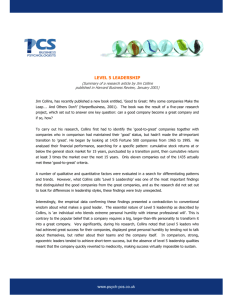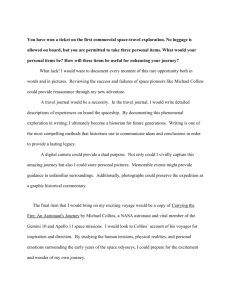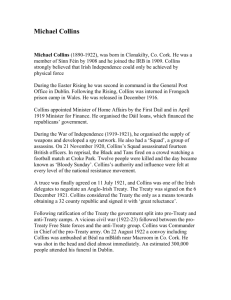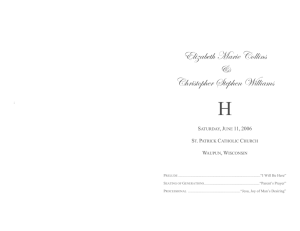introduction
advertisement
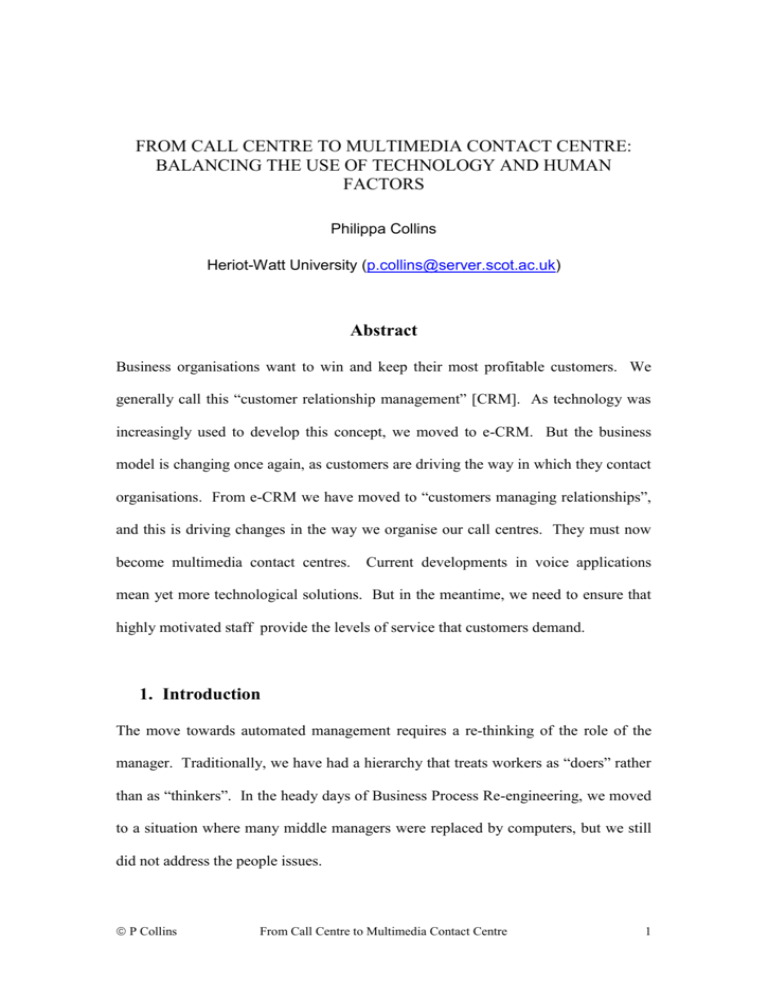
FROM CALL CENTRE TO MULTIMEDIA CONTACT CENTRE: BALANCING THE USE OF TECHNOLOGY AND HUMAN FACTORS Philippa Collins Heriot-Watt University (p.collins@server.scot.ac.uk) Abstract Business organisations want to win and keep their most profitable customers. We generally call this “customer relationship management” [CRM]. As technology was increasingly used to develop this concept, we moved to e-CRM. But the business model is changing once again, as customers are driving the way in which they contact organisations. From e-CRM we have moved to “customers managing relationships”, and this is driving changes in the way we organise our call centres. They must now become multimedia contact centres. Current developments in voice applications mean yet more technological solutions. But in the meantime, we need to ensure that highly motivated staff provide the levels of service that customers demand. 1. Introduction The move towards automated management requires a re-thinking of the role of the manager. Traditionally, we have had a hierarchy that treats workers as “doers” rather than as “thinkers”. In the heady days of Business Process Re-engineering, we moved to a situation where many middle managers were replaced by computers, but we still did not address the people issues. P Collins From Call Centre to Multimedia Contact Centre 1 One of the most important themes put forward by practising managers interviewed for this project is that the needs of staff must be given priority. They have recognised that technology only fulfils 30% of their needs. To provide highly effective customer service reliable information systems are required, but that alone will not satisfy, let alone delight, customers. The personal touch is a key factor. It is time to live up to the talk of empowerment, and used the creativity of every member of staff. Integration of all departments is key. Too often when we are discussing the subject of call centres, we forget the very basic principles of management. There will always be diversity of opinion about the “right” way to manage. The manner in which authority and control are exercised, and the way in which conflicts are resolved, have a significant influence on the productivity of our organisations. Management behaviours and styles are often embedded in cultural and historical traditions, and this paper is based on Western Europe, where management style is a key issue in the call centre industry. Emphasis has moved from managing the technology to managing people, and the contribution of personal contact is emerging as a critical success factor. The influence of theories from human resource management can be seen in many current studies. Yet in the UK call centres and contact centres still attract a bad press [TUC 2001]. 2. Methodology The current work began in 1998 when the author was awarded a BT Short-Term Research Fellowship at Adastral Park, Martlesham Heath. This was followed by a second fellowship in 1999, and was developed further after the appointment of a research assistant who had worked for a year in a call centre. An unpublished paper P Collins From Call Centre to Multimedia Contact Centre 2 [Collins & Sutherland 1999] based on that experience was described as “horribly fascinating” by colleagues, and led to an in-depth study of the subject. Despite the time-consuming nature of the method, the author has adopted a case study approach to this project. This is seen as a unique way of capturing information about human behaviour [Salkind 2000]. As the project is being carried out over a number of years, it is possible to capture not just descriptive snapshots but a picture of trends. It is also an important means of testing the theory and hype against reality. The author has an advantage in that she worked for many years in a number of organisations in both the public and private sectors. This industrial background gives both confidence and inside knowledge that in turn reassure the staff being observed. This trust leads to very honest appraisal of the situation under observation [Brewerton and Millward 2001]. The operational sites have been in the UK and Eire. They include BT’s National Control Centre [Coventry]; American Airlines and e-bookers [Dublin]; and other sites that have requested anonymity. Wider views have been gathered from attendance at conferences and the privilege of writing up conference proceedings [Collins 2001]. Sponsored attendance at international business conferences has led to opportunities to interview speakers and delegates, and to follow up such contacts over a period of time. The UK Call Centre Association [CCA] has also given access to important information and new contacts. The author is aware that due to the “politics” of some organisations, there is bias in some interviews. More reliance has therefore been put on contacts met through P Collins From Call Centre to Multimedia Contact Centre 3 “networking” and at conferences, where many frank exchanges take place during coffee breaks and lunch. This evidence can be compared with that gained from formal interviews and conference speeches, and with questions asked during breakout sessions. One operational site is noted for poor management practices but must remain anonymous. The TUC report [2001] also provides evidence to back up the results of the author’s work. 3. Current Issues in Call Centre Management The self-service model is fundamentally changing the way we do business. It is eliminating the “middle man” and reliance on 3rd parties, moving towards “disintermediation”, and reducing transaction costs. The shared service environment impacts the traditional view of organisations as functional hierarchies. According to KPMG [1999], services must now be re-classified into four areas: e-workforce – management and employees B2B – vendors and customers B2C – customers e-shareholder services – investors and analysts Ironically, if simple tools such as process maps are used, the interdependencies that occur in every organisation are soon obvious, and illustrate the fact that we have always had “shared services”. Because we have always trained functional specialists rather than generalists, this has not been as apparent as it should have been. The scope of this research has to be seen within this wider context. The top five issues in call centre management cited by American Airlines are: Employee training and support Employee engagement P Collins From Call Centre to Multimedia Contact Centre 4 Career development Multimedia integration Customer Relationship Management [CRM] According to KLA Tencor, the top five are: Staff recruitment Staff retention The working environment Working to a single aim Obtaining sufficient resources to maintain Service Level Agreements [SLAs] However, work in the field has suggested that a major issue is the development and implementation of an integrated “virtual team”. Not only do many companies operate across temporal and geographical boundaries [Jackson 1999]: their workers are distributed; they rely on collaborative software applications for communications; the number of employees teleworking is increasing; and there is a growing realisation that their focus must be external, not internal. That means that although technological developments are amongst the most important catalysts for change, managers must accept that customers are now driving change. Functional attitudes still prevent a holistic view of organisations. Companies are used to dictating to their customers. In 1991, an Economist article stated that: “The computer industry has long tried to tailor its computer systems to its customers’ needs. Now managers are discovering that they may have to tailor their businesses to the vast new power of computers”. Unfortunately, the dominance of such linear thinking persists, even after the disasters of business process re-engineering [BPR]. Fears have been expressed regarding technological determinism, [e.g. Birkhauser nd], and in the UK there is evidence that the customer is demanding a return to a more personal service. This may change over time, as a new generation that has grown up with computers comes of age. At present, however, CRM is changing to CMR: P Collins From Call Centre to Multimedia Contact Centre 5 customer managed relationships. With the glut of information available on the Internet, customers are now often ahead of business, and are increasingly knowledgeable and computer-literate. If a company does not provide the service level expected, the next company is only a click away. Coping with these circumstances means coping with massive culture change. A new phenomenon is the growth of email that is rapidly changing usage patterns. “The email has landed” and organisations are having difficulty in re-organising their operations to cope. Organisations that set up web sites thinking that this would reduce the volume of calls have been surprised to find not only that the number of contacts dramatically increases, but that their more sophisticated customers expect web chat, collaborative interfaces and email facilities. I tested this myself: Britannia Music reply to queries within 2 – 5 days. Three travel companies I have tested did not reply, then one of them sent me a customer care survey. I was pleasantly surprised to receive an answer from a manager, promising better service next time. I sent my next query directly to that manager, and still heard nothing! Agent shortages are a significant problem. Many organisations rely on agency staff, not just to deal with peaks of demand, but for general running of the business. In Ireland, there is such a shortage of skills that managers are recruiting overseas. Recruitment, attrition rates, agent training and pay are all high on management agendas. There will be some radical changes as voice technologies become more widely used. Sophisticated voice recognition systems will soon be commonplace. Using voice and video to replace humans may not answer all the demands of current P Collins From Call Centre to Multimedia Contact Centre 6 customers, but the youngsters of today will take these new methods of communication for granted. Cost will continue to be a factor. Call costs will reduce, as will the cost of the technology. As the role of the call centre is changing from a cost centre to a profit centre, costs will no longer be seen as a barrier. But organisational resistance to change, especially from functional managers, will continue to be a barrier for some time. 4. Changing the Culture There are two broad perspectives when looking at the management of change: the “rational” model [often based on “hard” systems thinking], and the “social” model, based on theories from the social sciences. Hofstede [1980] is one of many authors who suggests that inter-disciplinary approaches are required. C P Snow’s famous book [1964] described the debate between scientists and non-scientists as a: “gulf of incomprehension – sometimes…hostility and dislike, but most of all lack of understanding”. It can be argued that the gulf between the IT practitioners and business managers is equally broad. Morgan [1986] suggested that “mechanistic approaches to organisation have proved incredibly popular, partly because of their efficiency in the performance of certain tasks, but also because of their ability to reinforce and sustain particular patterns of power and control”. Such is the influence of systems thinking that a plethora of books and journals on various applications of the subject to business are available. Sir Geoffrey Vickers has discussed this at length. In his 1987 book he argued: P Collins From Call Centre to Multimedia Contact Centre 7 “Those who have earned their livings in the real world of action, know from experience the difference between solving a problem and understanding a situation. Academics are entitled, if they so wish, to confine their attention to matters which their favourite techniques can master. Technologists can do no more. But neither class is entitled to cut the real world down to the measure of its ideology. Nonetheless, deliberately or not, that is what they are doing”. Whatever the industry sector they represent, and whatever the communications technology in place, the employees in a call centre are in a service environment. To achieve customer loyalty and retention, the levels of service offered have to meet their demands and expectations. This means that the level of debate on service provision must rise above the “merely” technical and try to achieve a synthesis between the different ways of thinking about management. Snow’s “gulf of incomprehension” has to be bridged. 5. Human Factors: the Employee Perspective There are many sides to this issue of human factors. Leaving aside the needs of the customers, here the focus is internal, on the employees. “People” issues concern several different sectors. Just as call centres should not be treated as a single phenomenon, the employees should also be studied in different ways. Team analysis is essential, but there are other sub-divisions. There are call centre advisors and other call centre staff; and there are other, inter-dependent members of other departments. In BT Customer Service Teams, for example, the main units in the ‘virtual’ team are: Sales/marketing Engineers Customer service [call centres] Management The culture of each section differs. Sales personnel are considered [rightly or wrongly] to be more aggressive and more profit-orientated. Customer service staff P Collins From Call Centre to Multimedia Contact Centre 8 are expected to be more caring and to “bond” with their customers or demonstrate empathy. When discussing these factors, a representative from Shell Europe noted that it was very difficult to develop multi-skilled agents, who would cover both types of work. It is rare to find both traits in one person. The fact that managers refer to their customer service advisors as “agents” – thus dehumanising them - may be one reason for the poor public perception of the call centre industry. Other reasons include the vision of warehouses full of computers; with staff working in assembly-line ‘factories’ [e.g. Creagh 1998]; staff treated as second-class citizens as they are “only” call centre agents; and therefore they are treated badly and have a miserable job. That perception is exacerbated by the bad experiences customers have when contacting agents, either because their interaction with the interactive voice response [IVR] system irritates them, or because the agent cannot answer their queries. The customer wants a “one-stop shop” and expects the agent to have full knowledge of their history of transactions. Much of the frustration and dismay suffered by advisors stems from the lack of integrated systems and the need to change screens or even to change from one database to another. 6. Human Factors: Measurement and Service Levels As call centres were originally seen as a means of cost reduction, traditional workstudy methods have been used. Everything that can be controlled and measured is under scrutiny. Technology allows us to do this in such detail that we are inundated with data about agent performance. It is only recently that managers have begun to realise that the length of time that an advisor is on a call is irrelevant. It is the value of the transaction that is key. Too often, customer satisfaction is not measured. P Collins From Call Centre to Multimedia Contact Centre 9 Performance measurements are internally focused rather than focused on the levels of service attained. Kinnie [2000] suggests three types of call centre: Low commitment to employees, little flexibility Some commitment to employees, little flexibility High commitment to employees, and high flexibility Evidence of badly managed call centres is commonplace [e.g. Nurden 2000; web pages such as www.labournet.org.uk/1998]. Interviewees laugh wryly when recalling bad experiences listening to robot-like voices telling us to “Press 1 if you want X; press 2 if you want Y”. After 6 options, we had forgotten which number to press and had to wait for operator help - only to be put in a queue. Then there is the 50 pence-aminute help-line for email services. Operators hurry as much as they can, as they know the calls are costing the customer a small fortune to get the technical help they need. I want to be greeted by an employee who does not rush me, who is sympathetic to my needs, and who above all treats me as an intelligent human being. Why the hurry? If I am happy with the service I shall come back and spend more. Total time management is an excellent idea within an organisation, to cut out waste; to ensure processes are efficient and effective; to achieve lean administration. Since when did that idea mean that time spent with customers also had to be cut back? To judge by the number of times interviewees talked about customer relationship management, CRM is the current mantra. But what we have is not lean administration, but lean relationships. How can call centre operators offer good service if: they are only allowed a fixed number of seconds to reply to a customer, regardless of the complexity of the call they are not given sufficient training P Collins From Call Centre to Multimedia Contact Centre 10 they are not allowed breaks after dealing with difficult customers/queries time between calls [those micro-second breaks] is counted as part of the official break? This research project has revealed many more bad management practices. It is not just a matter of quality of service. Do you remember the Quality of Working Life [QWL] initiatives? For years before we began using the term TQM we were trying to move away from the idea that managers 'think' and workers 'do'. In the UK at present we are again being exhorted to encourage creativity and innovation. If you are sitting in front of a monitor for a full day's shift, what opportunities are there for creativity? Innovation? Continuous improvement? Far from being encouraged to suggest improvements, staff are closely monitored to ensure that they conform. Just how are employees to contribute, if all day they are sitting in front of computer screens, controlled like human robots, an extension of the machine rather than aided by it? A programmer interviewed during the project said that the logical extension of his work would be to write a program telling an employee that s/he was sacked. Everything he is required to develop is aimed at improving control. The manager has only to watch the monitor to know everything a member of staff is doing. So, he cynically suggested, why not program the computer to do the appraisal and to make the ultimate decision? At the Access conference [Collins 2001] there was clear evidence that the mood is changing. A few companies are trying self-managed teams. Speakers gave many examples of letting their teams offer suggestions for new working practices. The advisors spend all day talking to customers. They have far more ideas about what is important to the customer than senior management. An important message from the conference: Listen to your staff. P Collins They will tell you that although mass From Call Centre to Multimedia Contact Centre 11 communication through technological solutions is a given in the market today, there is huge pressure from customers to retain human contact. Despite the convergence of telecommunications, providing access to information any time, any place, anywhere, customer resistance is still strong. 7. Strategic Decisions and Direction Call centre management has become part of company strategy and vision. A call centre is the first point of contact with the customer’s company of choice for millions of people. It is therefore essential to have a consistent, integrated approach. Everyone who has studied strategy knows the old mantra: “Structure follows strategy”. Organisation design was severely challenged in the 90s with the implementation of business process re-engineering. Perhaps as a result of the bad experiences suffered then by so many managers, Computer Integrated Management CIM – is an acronym that has all but disappeared. Yet it is exactly what we are dealing with now. Over 10 years ago Weatherall [1988] stated: “a somewhat coldly analytical attitude to the existing operation of the business is recommended….departments can actually be disbanded [or combined]; their objectives or means of operation can, and sometimes should be, radically changed”. How many organisations have been brave enough to embrace such radical change? Outsourcing is one way of handling the management of a contact centre, but this a critical issue that raises many concerns. Service level agreements are just one aspect of what should be a partnership. Using outsourcing to manage seasonal fluctuations; using the service to trial new services; using outsourcing to utilise the expertise of an established company; avoiding the risks of trying out new technologies; using outsourcing so that you can focus on your core competencies: all that makes sense. P Collins From Call Centre to Multimedia Contact Centre 12 But the client wants consistency; protection of the brand and image of the company; a level of formality or informality that matches the culture of their company; knowledgeable advisors; and the right tone and style to match the end-user expectations. All those factors depend on people. If the outsourcer tries to squeeze margins, and treats staff badly in the way some of the research case studies indicate, clients are not going to get satisfied customers. In one particularly bad case, the situation was a result of a very poor service agreement at the outsourcing site. A major IT company used the service for offering technical advice on new equipment. The agents were allowed three minutes to answer a call – after that the outsourcing company had to pay the balance of the call costs. The pressures on the agents working on that contract became infamous. According to recent information, that same contract still exists; the terms have not been changed; and the agents working in that section are still unhappy. Staff in other sections on other contracts are noticeably more motivated and more interested in their jobs. It is disappointing to find that the TUC survey “it’s your call hotline” paints a similar picture. The killer app is voice: this is the message from technical gurus from a number of companies, and it is claimed that this technology will challenge the structure of the industry. According to BT [Swale 2001], Voice over IP [VoIP] has been around for longer than we realise. However, the underlying issues are “incredibly complex”, and “the very fact that such a range of terms abound continues to cause much confusion within the industry”. Several speakers at the Dublin call centre conference [Dublin 2001] gave impressive demonstrations of potential voice applications, the spirit of which it is impossible to replicate here. Some of the systems are still on trial, and details cannot be published here. P Collins From Call Centre to Multimedia Contact Centre 13 A recurring theme, however, is that technology was “the easy bit” and that all managers must now focus on people management and meeting ever-increasing customer expectations. Technology is the tool. The business aim must be to use that tool as an enabler to enhance customer service, not to make the customer interaction more difficult. The fact that every interviewee talked at length about people management was significant. Centralisation can be an issue. American Airlines is an example of the inevitable culture clash between the operation in Ireland that is a small [but important] subset of a huge American business. The business of American Airlines is to give passengers a quality travel service. Focus is on the facilities within the plane and at the airport. Yet the first point of contact for most people is the call centre, which is seen as a relatively small part of the business. Getting that message across – not just in American Airlines – is an important factor for every company. Call centre management has to be part of an overall strategy and vision. 8. Leadership Managers interviewed have begun to realise that they must behave as leaders; and that they must “walk the talk". There will not be much walking! Computers are taking over management itself. What value do managers add? Hammer hinted at this when he wrote "Don't automate, obliterate". We are so beguiled by the Internet and the potential of e-commerce and e-business that the increasing use of information technology as a control mechanism is rarely discussed. I have seen too many examples of control rather than empowerment to share the optimism of authors who P Collins From Call Centre to Multimedia Contact Centre 14 suggest that computers free us to manage our own destinies. When discussing methods of continuous improvement with teams in business, a recurring issue is their helplessness. They are dependent upon their IT systems, and those are chosen and developed by directors at such a high level, the teams have no say or influence. These teams feel that Taylorism is not just still with us, it is institutionalised. The hope was expressed that the Millennium would usher in a new workplace: "productive, profitable and inclusive, where respect and dignity for the members/workers is part of business as usual". Call centre workers do not yet feel that this has been achieved. Whilst managers are developing their CRM strategies, they must involve their staff at all levels. This will entail a massive culture change and shift in managerial attitudes. Evidence from this research suggests that it is happening – but very slowly. 9. Quality During the author’s work as an office manager, staff never talked about quality: they just did it. Only after formal training did the author understand the difference between quality control, quality assurance and total quality management [TQM], and it is her judgement that it is really just good management: what we should all be doing as a matter of course. Or perhaps you prefer that other interpretation of TQM: time to quit moaning – and DO something? Continuous improvement is the name of the game we are told, but too many people equate quality management with ISO 9000 and that little certificate that companies hang up in their reception area. It announces that “we’ve done quality”. Wrong! We now need radical innovation. Hamel [2000] suggests that continuous improvement is no longer sufficient. P Collins From Call Centre to Multimedia Contact Centre 15 It was therefore very interesting to hear Chris Halward [quoted in Collins 2001] offer a new angle. Halward suggests that instead of talking about performance management, we look at the contribution that people make to the organisation. He cleverly linked people issues, management and measurement. Marketing aims to win the hearts and minds of customers. If we can win the hearts and minds of our staff, we can move towards partnerships. We can create levels of service that not only satisfy but delight our customers. This call for action echoes the presentation from David Rance [at the same conference], who pointed out that the key issue facing businesses is how to become truly customer-centric without paying lip service to it. Customers can see through marketing hype and insincerity. As the song goes, “It ain’t what you do it’s the way that you do it!” In work with large organisations, this author has found that one reason for lack of quality is lack of understanding of how the organisation works. People have no holistic view of the business as they focus on their own function. One means of persuading them to ‘look outside the box’ and indulge in some lateral thinking is to use process mapping [Collins 1997]. Flowcharts are an under-estimated tool. They show inter-dependencies between functions and as they are totally neutral, they can be used to develop partnerships. Turf wars are too often based on lack of data and management perceptions developed from years of working in stove-piped organisations. The Call Centre Association [CCA] Framework for Best Practice is a new way forward, as yet not fully tested. The details of this standard are to be found at www.cca.org.uk. The CCA has responded in many TV, radio and press interviews to P Collins From Call Centre to Multimedia Contact Centre 16 the negative press that surrounds the industry. The CCA have emphasised that in every industry sector there are good and bad players, but it is their belief that CCA members have joined a professional body to demonstrate their commitment to excellence, both in employee relations and customer satisfaction. The existence of the CCA demonstrates the will to pursue a positive, progressive strategy within the industry. There are already over 440 members in the UK, and the opportunity for research, benchmarking and other activities is an important development. There will be a progress report at the CCA 7th Annual Convention [November 2001, conference proceedings to be edited by the author]. The COPC standard developed in 1995/6 by Microsoft, Motorola and now used in more than 200 locations was discussed by only one of the managers or speakers interviewed, and several had not heard of it. Whilst the aim of this standard is highly commendable, the detail required for implementation raises the spectre of ISO 9000 Series bureaucracy. It is now being used by companies in the UK, and is an area that will be included in future research. If it encourages internal focus, and leads to more “Taylorist” practices, it could stifle current efforts to increase staff creativity and involvement in call centre management. 10. Conclusions WHITHER MANAGEMENT? That is the key question. It is not about how much technology we have, but about how we really want to work and what experience we wish to offer to customers. How can we improve operations management within our organisations? Are there better ways to invest in resources with the ability to delight P Collins From Call Centre to Multimedia Contact Centre 17 customers? What is needed is thinking that promotes better relationships, both internally and externally. The ability to recruit, train, motivate and retain high quality staff is the most important challenge facing the industry. Providing an enjoyable working experience for staff is as important as developing systems and processes that speed up and facilitate communications with customers. Call centres will continue to play a part in the provision of high quality customer service. New technology will automate yet more of the routine tasks, but those developments must be balanced with the need to provide user-friendly interfaces. The call centre industry is not homogenous: it is not possible to cope with very varied customer demands across all industrial groups in the same way. It has been said that the work of contact centres should be widened, so that all advisors become skilled in sales and marketing. Against that trend is the fact that customers may not want that pressure. If they contact you for a query about their flight check-in, they expect a call lasting a matter of seconds, not a sales pitch. Prioritising is another difficult issue. Choosing which customers to offer Gold treatment is not an easy undertaking. If the wife of a senior executive rings from a number not on your priority list, how will she feel if she is kept waiting in a queue? New customers may later turn into very valuable clients – so if their first experience of your company is an inferior one, they may move elsewhere. Another challenge is the need to educate the press and public so that there is a wider recognition of the role call centres play in the provision of high quality customer P Collins From Call Centre to Multimedia Contact Centre 18 service. New technology will automate yet more of the routine tasks, but those developments must be balanced with the need to provide user-friendly interfaces. Management issues will continue to dominate the industry as it is more widely recognised that people issues are more important than either technical or economic concerns. It used to be said that “Quality is free.” That is still true to the extent that good quality means that you have cut out wasteful practices; you have streamlined your processes and technology to make them customer facing; and you have empowered your front-office agents to make decisions. By removing layers of management, and building an atmosphere of trust, you energise your staff and make their work more worthwhile. Many years ago, Mary Parker Follett [1949] stated: “The important thing about responsibility is not to whom you are responsible, but for what you are responsible.” As motivation increases, staff loyalty grows and attrition rates decrease. In turn, customer service levels increase and customer retention and loyalty grows. The aim must be to create this virtuous circle in our virtual world of multimedia contact centres. Acknowledgements Many people have given much time for this project: for this I am sincerely grateful. Particular thanks are due to BT for sponsoring two short-term research fellowships; to Access Conferences Ltd for permission to attend their conferences and record the data; to Hilary Doyle [American Airlines] and Sandra Hyde [KLA-Tencor] for personal communications; and to a number of contact centre organisations in the UK and Eire [that would prefer to remain anonymous] for allowing extended visits. P Collins From Call Centre to Multimedia Contact Centre 19 References 1) 2) 3) 4) 5) 6) 7) 8) 9) 10) 11) 12) 13) 14) 15) 16) 17) 18) 19) 20) 21) 22) Brewerton P & Millward L 2001 Organizational Research Methods Sage Birkhauser [nd] Technological Determinism in the Twentieth Century http://cartoon.ecn.purdue.edu/~birkhaus [downloaded 21 December 1999] Collins P 1997 Using Process Mapping as a Quality Tool Management Services March pp 24 - 26 Collins P & Sutherland S 1999 Life in a Call Centre: the Reality [unpublished] Collins P [Editor] 2001 From Call Centre to Multimedia Customer Interaction Centre Conference Proceedings, Dublin March Access Conferences International Ltd [in press] COPC-2000: Customer Operations Performance Center Inc. www.copc.com Creagh M 1998 Call Centres: the new assembly lines? Chartered Secretary September pp 32 – 33 The Economist Reinventing Companies October 12 1991 pp 105-106 Follett M P 1949 Freedom and Co-ordination Management Publ. Trust London p 46 Hamel G 2000 Leading the Revolution Harvard Business School Press Hammer M 1990 Re-engineering Work: Don’t Automate, Obliterate i. HBR July-August Hofstede G 1980 Culture’s Consequences Sage Jackson P [Editor] 1999 Virtual Working Routledge Kinnie N 2000 Rules of Engagement People Management 8 June pp 34 – 38 KPMG 1999 Second Generation Shared Services [sent as personal communication] Morgan Gareth 1986 Images of Organisation Sage Nurden R 2000 Chains break – but we stay in the workhouse The Independent on Sunday 5 November Salkind N 2000 Exploring Research 4th Edition Prentice Hall Snow C P 1964 The Two Cultures Mentor Swale R 2001 Foreword BT Technology Journal Vol. 19 No 2 April p 7 TUC Call Centre Workers Campaign “It’s your call” TUC April 2001 Vickers Sir G 1987 Policymaking, Communication and Social Learning Transaction Books Weatherall A 1988 CIM: from fundamentals to implementation Butterworths 23) 24) www.labournet.org.uk/1998 P Collins From Call Centre to Multimedia Contact Centre 20
